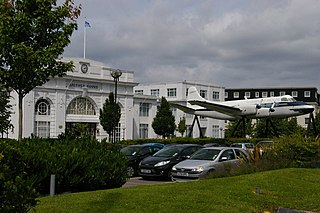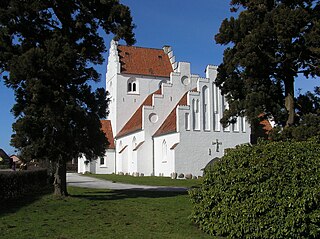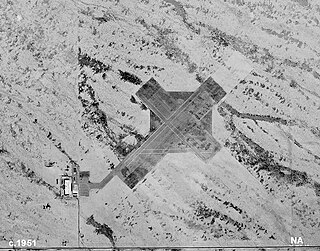
Croydon Airport was the UK's only international airport during the interwar period. Located in Croydon, Surrey, England, it opened in 1920, built in a Neoclassical style, and was developed as Britain's main airport, handling more cargo, mail, and passengers than any other UK airport at the time. Innovations at the site included the world's first air traffic control and the first airport terminal. During World War II the airport was named RAF Croydon as its role changed to that of a fighter airfield during the Battle of Britain; and in 1943 RAF Transport Command was founded at the site, which used the airport to transport thousands of troops into and out of Europe.
The Technical University of Denmark, often simply referred to as DTU, was founded in 1829 at the initiative of Hans Christian Ørsted as Denmark's first polytechnic, and it is today ranked among Europe's leading engineering institutions. It is located in the town Kongens Lyngby, 12 kilometres (7.5 mi) north of central Copenhagen, Denmark.

The former Royal Air Force Station Kenley, more commonly known as RAF Kenley was an airfield station of the Royal Flying Corps in the First World War and the RAF in the Second World War. It played a significant role during the Battle of Britain as one of the three RAF stations specifically tasked with the defence of London. It is located near Kenley on the edge of Greater London. The site remains in use with the Ministry of Defence, as Kenley Airfield.

Lyngby Boldklub is a Danish professional football club founded in 1921. It is based at Lyngby Stadion in Kongens Lyngby, Lyngby-Taarbæk Municipality, a northern suburb of Copenhagen. From 1994 to 2001 the club was known as Lyngby FC. The club has won the Danish championship twice and the Danish Cup three times.

Royal Air Force Hooton Park or more simply RAF Hooton Park, on the Wirral Peninsula, Cheshire, is a former Royal Air Force station originally built for the Royal Flying Corps in 1917 as a training aerodrome for pilots in the First World War. During the early/mid-1930s, it was one of the two airfields handling scheduled services for the Merseyside region. Hooton Park was home to No. 610 Squadron and, post Second World War, to No. 611 and No. 663 (AOP) Squadron.

Waco Regional Airport is five miles northwest of Waco, in McLennan County, Texas. It is owned by the City of Waco.

Canadian Forces Base Comox, commonly referred to as CFB Comox or 19 Wing, is a Canadian Forces Base located 2.5 nautical miles north northeast of Comox, Vancouver Island, British Columbia. It is primarily operated as an air force base by the Royal Canadian Air Force (RCAF) and is one of two bases in the country using the CP-140 Aurora anti-submarine/maritime patrol and surveillance aircraft. Its primary RCAF lodger unit is 19 Wing, commonly referred to as 19 Wing Comox.

Hendon Aerodrome was an aerodrome in London, England, that was an important centre for aviation from 1908 to 1968.

Plum Island Airport, in Newburyport, Massachusetts, is a privately owned, public-use airport owned by Historic New England and operated by Plum Island Aerodrome, Inc., a non-profit corporation. It has two runways, averages 54 flights per week, and has approximately 8 based aircraft.

Netherthorpe Aerodrome is located 2 NM west by north of Worksop, Nottinghamshire, England. The aerodrome is in the Metropolitan Borough of Rotherham close to the village of Thorpe Salvin.

Bathurst Airport is an airport serving Bathurst, New South Wales, Australia.

Lundtofte is a neighbourhood in Lyngby-Taarbæk Municipality, located north of Kongens Lyngby. The town is bordered by Nærumbanen, the Mølleåen river, the Technical University of Denmark and the Helsingørmotorvejen. DTU is situated on the location of the former Lundtofte Flyveplads.

General aviation in the United Kingdom encompasses a variety of commercial and non-commercial aviation activities.
Reid and Sigrist was an English engineering company based at New Malden in Surrey. It later acquired sites at Desford and Braunstone in Leicestershire. Initially it developed and manufactured aircraft instrumentation and pilot selection aids but later diversified into flying training and aircraft design. During World War II the company was part of the Civilian Repair Organisation repairing, rebuilding and converting warplanes at the Desford site. Post-war, it continued to manufacture aviation instruments and guidance systems but also diversified further to produce cameras and optical instruments. In 1954, the company was purchased and taken over by the Decca Record Company.

Uetersen Airfield is an aerodrome near the town of Uetersen in the district of Pinneberg within the municipalities of Heist and Appen.

Echeverria Field is an abandoned airfield, located approximately 15 miles (24 km) west of Wickenburg, Arizona.

London Air Park, also known as Hanworth Air Park, was a grass airfield in the grounds of Hanworth Park House, operational 1917–1919 and 1929–1947. It was on the southeastern edge of Feltham, now part of the London Borough of Hounslow. In the 1930s, it was best known as a centre for private flying, society events, visits by the Graf Zeppelin airship, and for aircraft manufacture by the Whitehead Aircraft Company during World War I and General Aircraft Limited (GAL) 1934–1949; in total over 1,650 aircraft were built here.

Kløvermarken is a large green space in the Amager East district of Copenhagen, Denmark. Originally a military area, it has later been home to both Copenhagen's first air field and a camp for German refugees after World War II. It now sports football pitches and other sports facilities as well as a nature centre for children.

Avedøre Airfield, located in Hvidovre Municipality, west of central Copenhagen, is the oldest operational airfield in Denmark. It is situated at the intersection of Gammel Køge Landevej with the Ring 3 motorway. It is now known s Aeronautisk Aktivitetscenter Avedøre (AAA) and used as a centre for vintage aircraft. The oldest buildings at the site are two wooden hangars that date from its establishment in 1917.
Cramlington Aerodrome was a military airfield established in Northumberland during the First World War. It became a civil airfield serving the Tyneside area of north-east England and operated until 1935, when it was replaced by Woolsington Airport, now known as Newcastle International Airport.



















